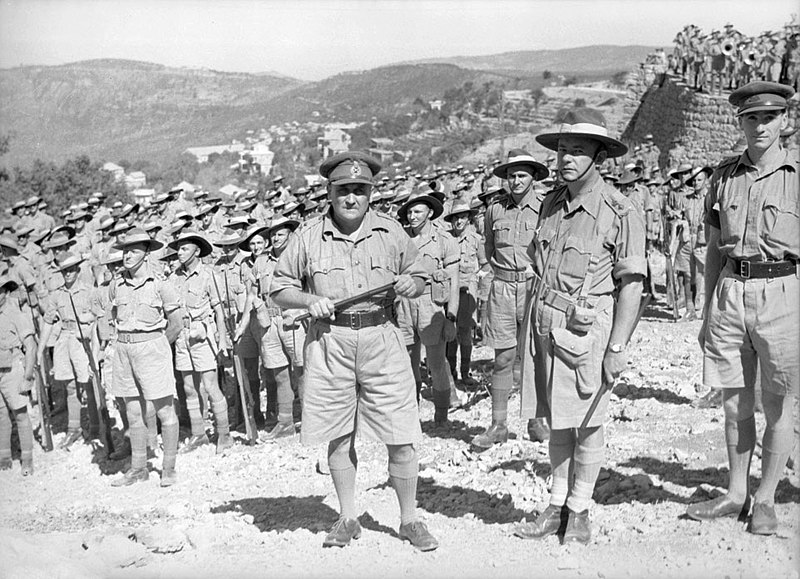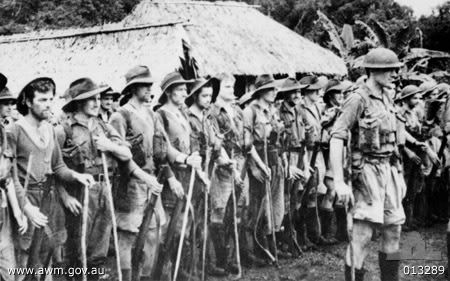
His inter-war career was slow, but he attended the Quetta Staff College where his performance resulted in appointments to Army Headquarters in Delhi and then Staff College, Camberley,

where he taught from 1934 to 1937. Promoted to lieutenant-colonel in 1938, Slim commanded 2nd Battalion, 7th Gurkha Rifles before becoming head of the Senior  Officers' School at Belgaum.
Officers' School at Belgaum.
 Officers' School at Belgaum.
Officers' School at Belgaum.As commander of the 10th Indian Brigade, Slim took part in the conquest of Abyssinia (1940-41) 
 where he was again wounded. Promoted to major-general in June 1941, he led 10th Indian Division during
where he was again wounded. Promoted to major-general in June 1941, he led 10th Indian Division during
 as an opportunity to press for full Iraqi independence following the limited independence granted in 1932
as an opportunity to press for full Iraqi independence following the limited independence granted in 1932.gif) .But things did not go as planned and Britain reacted by landing the Indian 20th Infantry Brigade at Basra on April, 18. The war lasted until May, 31, 1941 with return to power of the ousted pro-British Regent of Iraq, Prince Abdollah…
.But things did not go as planned and Britain reacted by landing the Indian 20th Infantry Brigade at Basra on April, 18. The war lasted until May, 31, 1941 with return to power of the ousted pro-British Regent of Iraq, Prince Abdollah… 

 where he was again wounded. Promoted to major-general in June 1941, he led 10th Indian Division during
where he was again wounded. Promoted to major-general in June 1941, he led 10th Indian Division duringabove photo from the best ww2 blogWWII Plastic Toy Soldiers
the Iraq expedition, the Syria-Lebanon campaign, and the invasion of Iran.On April, 1, 1941, the army chief of staff staged a coup in Iraq andRashid Ali Gilani toppled the British puppet ruler. He intended to use the WWII as an opportunity to press for full Iraqi independence following the limited independence granted in 1932
as an opportunity to press for full Iraqi independence following the limited independence granted in 1932.gif) .But things did not go as planned and Britain reacted by landing the Indian 20th Infantry Brigade at Basra on April, 18. The war lasted until May, 31, 1941 with return to power of the ousted pro-British Regent of Iraq, Prince Abdollah…
.But things did not go as planned and Britain reacted by landing the Indian 20th Infantry Brigade at Basra on April, 18. The war lasted until May, 31, 1941 with return to power of the ousted pro-British Regent of Iraq, Prince Abdollah… 
In March 1942 he was promoted to command Burma Corps, which had been chased out of Rangoon by the Japanese. Heavily outnumbered, Slim was forced to withdraw to India, but he made sure the 900-mile (1400 km) retreat did not turn into a rout, leading a controlled military withdrawal. Slim then took over XV Corps of the Eastern Army in the Arakan in April 1943.
Heavily outnumbered, Slim was forced to withdraw to India, but he made sure the 900-mile (1400 km) retreat did not turn into a rout, leading a controlled military withdrawal. Slim then took over XV Corps of the Eastern Army in the Arakan in April 1943. The campaign was a disaster, partly because General Noel Irwin, the Eastern Army’s commander, sidelined Slim. The subsequent fall-out led to Irwin’s dismissal and Slim’s appointment as commander of 14th Army Slim emphasised the need for jungle warfare training and the use of more aggressive tactics that included the formation of defensive 'boxes' by surrounded units that were supplied by air.
The campaign was a disaster, partly because General Noel Irwin, the Eastern Army’s commander, sidelined Slim. The subsequent fall-out led to Irwin’s dismissal and Slim’s appointment as commander of 14th Army Slim emphasised the need for jungle warfare training and the use of more aggressive tactics that included the formation of defensive 'boxes' by surrounded units that were supplied by air. Perhaps his greatest contribution though was that of talking to soldiers and restoring their morale. He was a fine manager of men and able to get them to do his bidding. Slim undertook a partially successful attack in the Arakan in February 1944, and then, in the battles of Imphal and Kohima,
Perhaps his greatest contribution though was that of talking to soldiers and restoring their morale. He was a fine manager of men and able to get them to do his bidding. Slim undertook a partially successful attack in the Arakan in February 1944, and then, in the battles of Imphal and Kohima, repelled a Japanese invasion of north-east India. Both campaigns demonstrated that his new approach worked. The Japanese were able to encircle the formations of 14th Army, but could not defeat them, losing over 60,000 men and exhausting themselves in the process.
repelled a Japanese invasion of north-east India. Both campaigns demonstrated that his new approach worked. The Japanese were able to encircle the formations of 14th Army, but could not defeat them, losing over 60,000 men and exhausting themselves in the process.
 Heavily outnumbered, Slim was forced to withdraw to India, but he made sure the 900-mile (1400 km) retreat did not turn into a rout, leading a controlled military withdrawal. Slim then took over XV Corps of the Eastern Army in the Arakan in April 1943.
Heavily outnumbered, Slim was forced to withdraw to India, but he made sure the 900-mile (1400 km) retreat did not turn into a rout, leading a controlled military withdrawal. Slim then took over XV Corps of the Eastern Army in the Arakan in April 1943. The campaign was a disaster, partly because General Noel Irwin, the Eastern Army’s commander, sidelined Slim. The subsequent fall-out led to Irwin’s dismissal and Slim’s appointment as commander of 14th Army Slim emphasised the need for jungle warfare training and the use of more aggressive tactics that included the formation of defensive 'boxes' by surrounded units that were supplied by air.
The campaign was a disaster, partly because General Noel Irwin, the Eastern Army’s commander, sidelined Slim. The subsequent fall-out led to Irwin’s dismissal and Slim’s appointment as commander of 14th Army Slim emphasised the need for jungle warfare training and the use of more aggressive tactics that included the formation of defensive 'boxes' by surrounded units that were supplied by air. Perhaps his greatest contribution though was that of talking to soldiers and restoring their morale. He was a fine manager of men and able to get them to do his bidding. Slim undertook a partially successful attack in the Arakan in February 1944, and then, in the battles of Imphal and Kohima,
Perhaps his greatest contribution though was that of talking to soldiers and restoring their morale. He was a fine manager of men and able to get them to do his bidding. Slim undertook a partially successful attack in the Arakan in February 1944, and then, in the battles of Imphal and Kohima, repelled a Japanese invasion of north-east India. Both campaigns demonstrated that his new approach worked. The Japanese were able to encircle the formations of 14th Army, but could not defeat them, losing over 60,000 men and exhausting themselves in the process.
repelled a Japanese invasion of north-east India. Both campaigns demonstrated that his new approach worked. The Japanese were able to encircle the formations of 14th Army, but could not defeat them, losing over 60,000 men and exhausting themselves in the process.
above photo from the best ww2 blogWWII Plastic Toy Soldiers
Slim now drove the nips south. Fighting through the monsoon and supplied by air, his men crossed the River Chindwin, took Akyab in the Arakan, and won bridgeheads across the Irrawaddy. After fierce fighting Meiktila and Mandalay were captured in March 1945.both photos from ww2plastic soldier bog , check it out The route south to Rangoon now lay open and 4th Corps was only 30 miles (48 km) away when the city fell to a combined air and seaborne operation in May. It was a victory won through the courage
The route south to Rangoon now lay open and 4th Corps was only 30 miles (48 km) away when the city fell to a combined air and seaborne operation in May. It was a victory won through the courageabove photo from the best ww2 blogWWII Plastic Toy Soldiers
 and endurance of the troops and the superb generalship of Slim. After the war he was Commandant of
and endurance of the troops and the superb generalship of Slim. After the war he was Commandant of  the Imperial Defence College (1946-48) and then Chief of the Imperial General Staff (1948-52).
the Imperial Defence College (1946-48) and then Chief of the Imperial General Staff (1948-52).  Between 1953 and 1960 Slim was governor-general of Australia.Without Slim there could never have
Between 1953 and 1960 Slim was governor-general of Australia.Without Slim there could never have above photo from the best ww2 blogWWII Plastic Toy Soldiers
 been a Gandhi who would have been executed straight away if the nips had got india.
been a Gandhi who would have been executed straight away if the nips had got india.
No comments:
Post a Comment